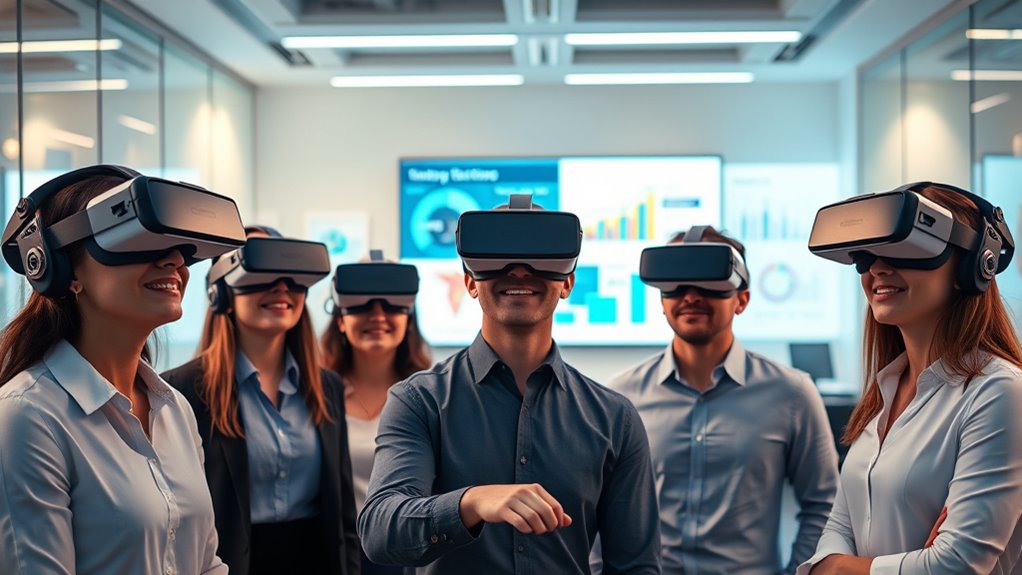Virtual reality (VR) for training and simulation in business gives you immersive experiences that mimic real-world scenarios. This tech boosts engagement and retention, with studies showing an 80% retention improvement versus traditional methods. Industries like healthcare, aviation, and retail are already reaping the benefits. Plus, VR can save on training costs and time dramatically. If you keep exploring, you’ll uncover even more about its impactful applications in the business world.
Key Takeaways
- Virtual reality training offers immersive learning experiences, simulating real-world scenarios to enhance employee skills and knowledge retention.
- Industries like healthcare, retail, manufacturing, and aviation leverage VR to conduct risk-free and effective training.
- Companies like Walmart and Emirates Airlines demonstrate significant reductions in training time and improved employee preparedness through VR applications.
- VR training reduces costs and physical facility needs, making it a cost-effective solution for businesses.
- Statistics show that 75% of Fortune 500 companies utilize VR training, highlighting its growing adoption and efficacy in corporate training programs.
Definition and Overview of Virtual Reality Training
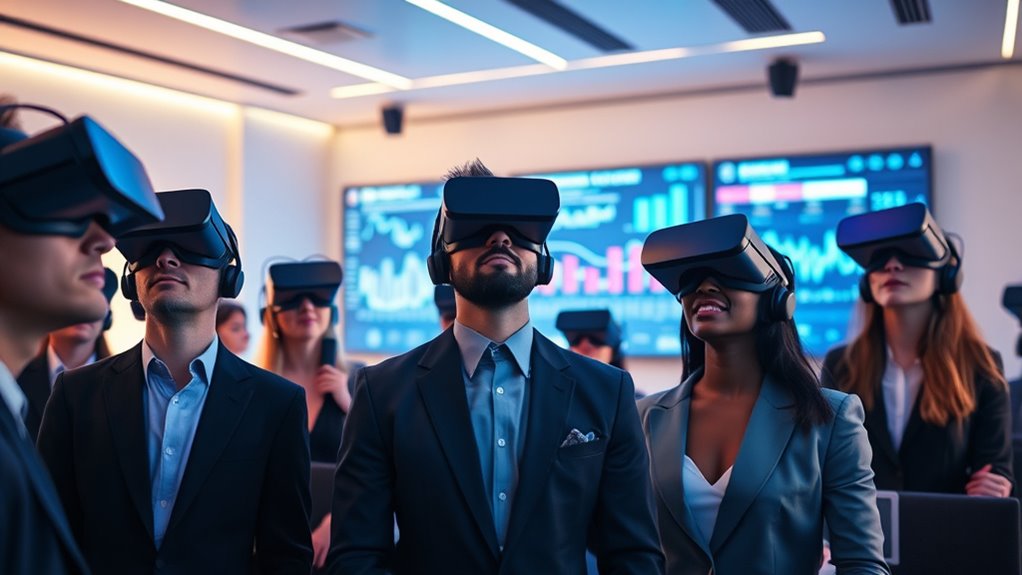
Virtual reality training is revolutionizing how businesses approach skill development by providing immersive learning experiences that closely mimic real-world scenarios. This innovative method relies on advanced technology, including VR headsets and controllers, to create realistic environments for training.
With simulation-based training and six degrees of freedom (6DoF), you can interact with virtual environments in a way that enhances your skills, whether you’re in healthcare, aviation, or construction.
VR training is also cost-effective, reducing traditional expenses like travel and equipment. Plus, the use of digital twins allows for efficient simulations of complex systems.
As technology evolves, VR training will continue to offer scalable and updated content, ensuring you stay relevant in your field.
Key Benefits of Virtual Reality Training
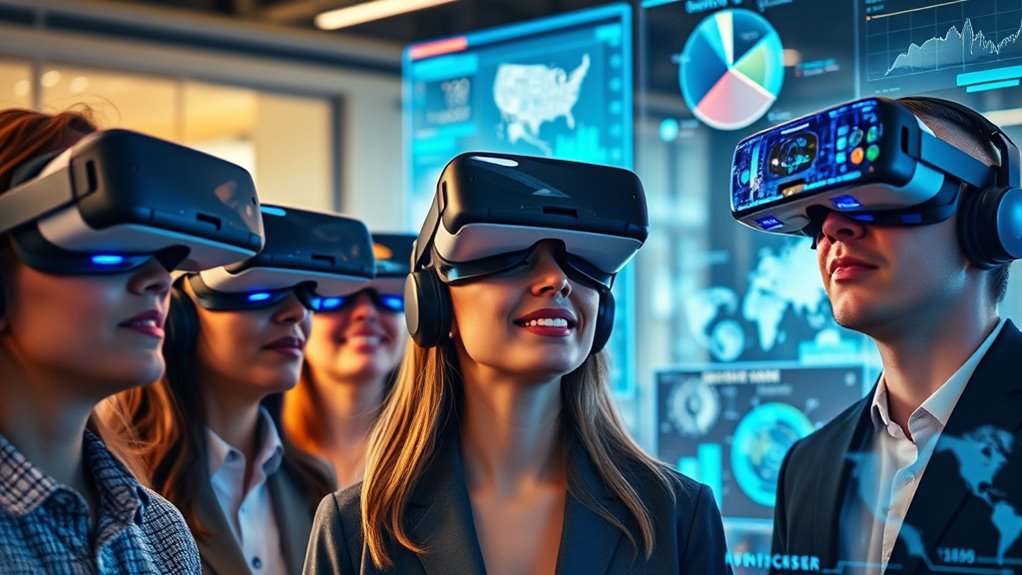
While traditional training methods often struggle to keep learners engaged, VR training offers a dynamic alternative that captivates employees and enhances their skill development.
With immersive experiences, you’ll find increased engagement and interaction, leading to better learning outcomes. Realistic simulations allow you to practice in controlled environments, improving retention rates significantly—studies show up to 80% retention compared to conventional methods.
Plus, VR training is cost-effective, reducing the need for physical facilities and travel. You’ll also benefit from data-driven insights on your performance, enabling personalized learning experiences.
Industries Embracing Virtual Reality Training
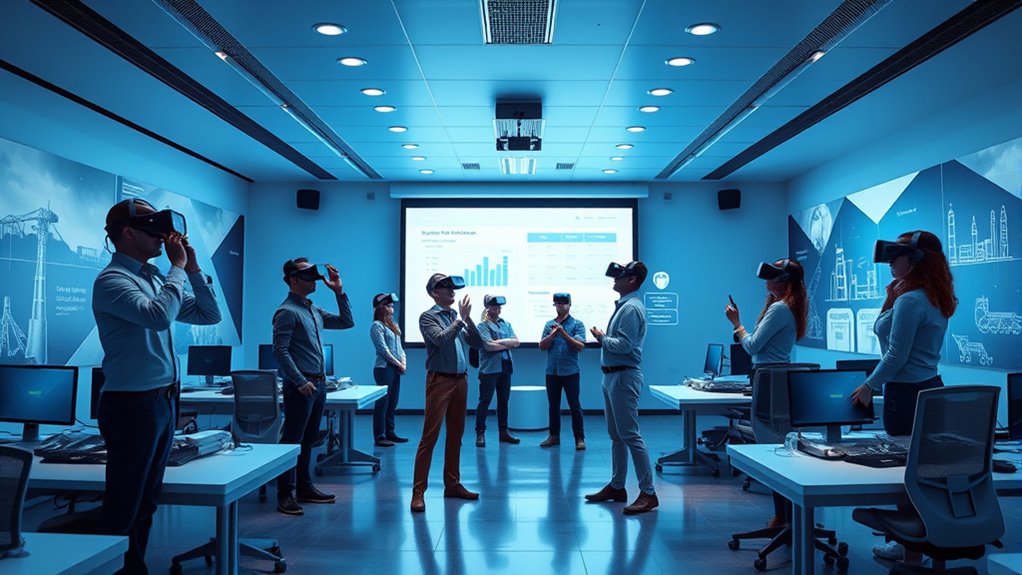
Across various sectors, businesses are increasingly adopting virtual reality (VR) training to enhance their workforce’s skills and efficiency.
In healthcare, professionals practice complex procedures risk-free, while retailers like Walmart and Lowe’s boost customer service training through immersive experiences.
Manufacturing companies such as Toyota and Siemens train employees on machinery operation, significantly improving safety protocols.
Law enforcement agencies utilize VR to prepare officers for real-world scenarios, enhancing response times.
The aviation sector also benefits, as pilots practice flight simulations without real-world risks.
Additionally, industries like automotive and construction leverage VR for pre-training and equipment operation, demonstrating the broad appeal and effectiveness of VR training across different fields.
Embracing VR can revolutionize your training approach and workforce development.
Success Stories: Real-World Applications of VR Training
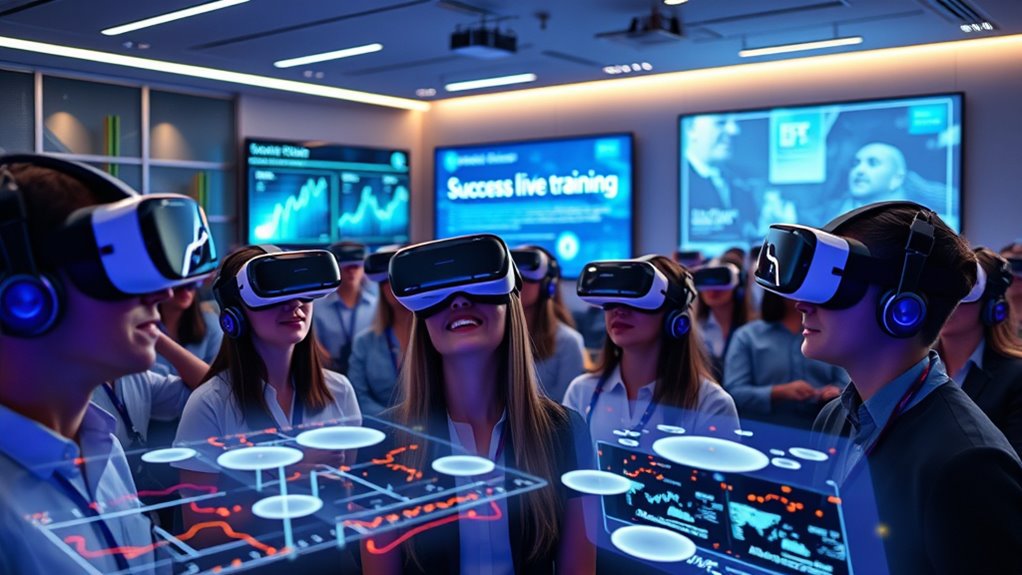
Success stories in various industries showcase the transformative power of VR training.
At Walmart, you’d find training times slashed by 96%, going from 8 hours to just 15 minutes, while employee satisfaction jumped by 30%.
In aviation, Emirates Airlines trained over 23,000 cabin crew members, enhancing emergency preparedness and reducing the need for physical simulators.
Meanwhile, healthcare professionals using VR showed significant skills retention, and surgeons trained in VR performed tasks 29% faster with six times fewer errors.
Deutsche Telekom reported a 10% improvement in communication skills after just one VR session.
These examples highlight how VR not only increases efficiency but also boosts confidence and engagement among employees across various sectors.
Statistics on Virtual Reality Training Adoption
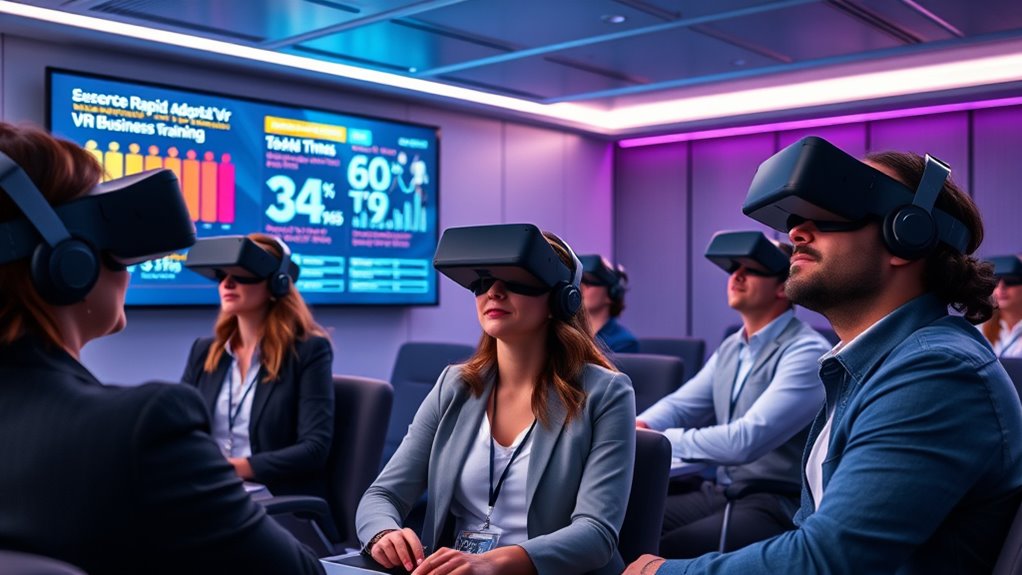
You might be surprised to learn that 39% of enterprises are now using VR/AR technology for training, a significant jump from 26% in 2020.
With VR training reducing costs and training time by up to 75%, it’s no wonder that 75% of Fortune 500 companies have embraced this technology.
As the global VR training market continues to grow at a staggering rate, the demand for cost-efficient and effective training solutions is becoming impossible to ignore.
Adoption Growth Trends
As businesses increasingly recognize the benefits of immersive learning, the adoption of virtual reality (VR) training is on the rise. By 2020, 26% of businesses were already using VR/AR for employee training, and that figure jumped to 39% as enterprises embraced this innovative approach.
The global VR training market is projected to grow at over 30% annually, indicating strong momentum. Notably, 77% of employees show better learning retention through VR training compared to traditional methods.
Industries like healthcare, energy, and manufacturing are leading the charge, while companies like Walmart and Airbus showcase successful implementations.
With enhanced realism and accessibility, VR training is set to revolutionize how you develop skills and boost employee engagement in your organization.
Cost Reduction Benefits
Virtual reality training not only enhances learning but also offers significant cost reduction benefits for businesses. By eliminating travel costs and venue rentals, you can save substantially on logistics.
Employees can access training from anywhere, reducing downtime and maximizing productivity. Once developed, VR content is scalable and reusable, ensuring consistent experiences across your organization without additional costs.
With faster learning processes and higher engagement levels, you’ll see improved skill acquisition and retention. Although the initial investment in VR might be higher, studies show that it can cut training costs by up to 64% for larger groups.
Ultimately, VR training delivers long-term savings while enhancing efficiency and safety, making it a smart choice for your business.
Challenges and Future Directions for Virtual Reality Training
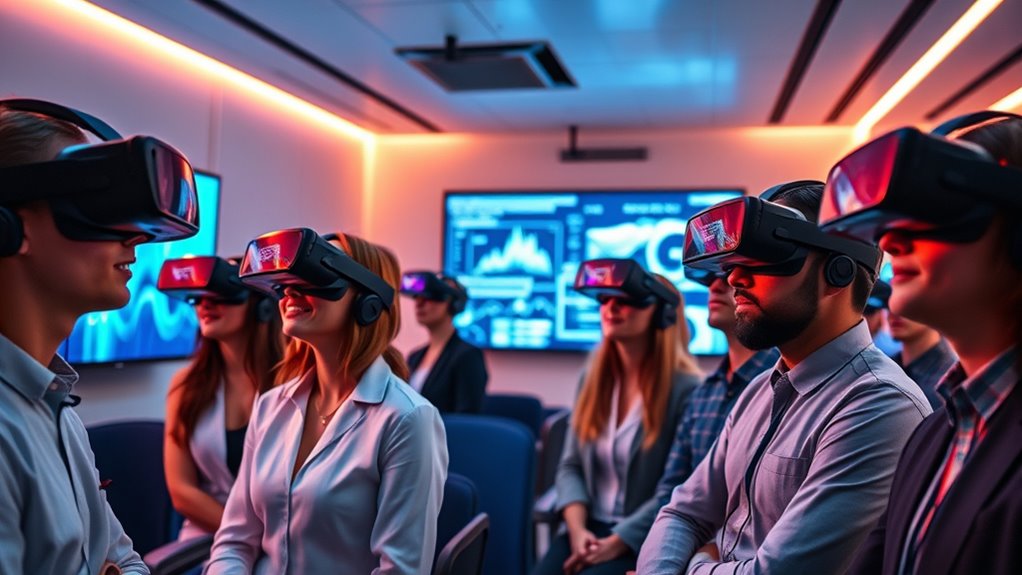
While the promise of virtual reality (VR) training is enticing, several challenges hinder its widespread adoption in business environments.
Technological limitations, such as motion sickness and varying realism, can affect training quality. High initial costs for hardware and custom development deter many organizations. Accessibility issues, especially with internet speed, further complicate implementation. Health concerns like eye strain and employee resistance to new tech can also stall progress.
Looking ahead, advancements in VR hardware promise affordability and improved immersion. Customization and scalability will allow tailored training experiences, while robust ROI measurement will track engagement and effectiveness.
Integrating VR with other technologies can enhance training, making it a versatile tool across industries. Addressing these challenges can unlock VR’s potential in business training.
Frequently Asked Questions
What Types of VR Equipment Are Commonly Used for Training?
When considering VR equipment for training, you’ll typically find head-mounted displays (HMDs) that immerse you in a 360-degree environment.
Motion controllers let you interact with virtual objects, while sensors track your movements for accurate feedback.
Haptic devices provide tactile sensations, enhancing immersion.
Depending on your industry, specialized simulators, like those for aviation or medical training, can also be crucial.
High-performance computers ensure everything runs smoothly, creating an effective learning experience.
How Long Does It Take to Develop VR Training Content?
When you’re looking to develop VR training content, expect the process to take anywhere from 4 weeks to 6 months.
It all depends on the complexity of your project, the intensity of programming, and the expertise of your developers.
Typically, you’ll spend 1-8 weeks on instructional design, followed by 4 weeks to several months for asset creation, and another 1-8 weeks for development and programming.
Each stage contributes to the overall timeline.
Can VR Training Be Customized for Specific Company Needs?
Imagine stepping into a training session that’s tailor-made just for you.
Can VR training be customized for specific company needs? Absolutely! You’ll find that VR can adapt to various industries, creating unique scenarios that resonate with your team’s challenges.
With rapid development and content builder tools, you can easily design immersive experiences that enhance engagement and retention.
What Are the Hardware Requirements for VR Training?
For effective VR training, you’ll need specific hardware components. Start with a high-quality VR headset, like the Meta Quest or HTC Vive, for immersive experiences.
Input devices, such as motion controllers and haptic gloves, enhance interaction. Ensure your computer has a powerful processor (Intel i5 or AMD Ryzen), a capable graphics card (NVIDIA GTX 970), and at least 8GB RAM.
Don’t forget proper connectivity and compatible software for a seamless experience.
How Do Companies Measure the Effectiveness of VR Training?
To measure the effectiveness of training, companies track several key performance indicators.
You’ll see metrics like knowledge retention, task completion time, and error rates. They also gather trainee satisfaction through surveys, ensuring the experience meets expectations.
Quantitative methods involve data collection and simulation metrics, while qualitative approaches include focus groups and feedback.
Conclusion
Incorporating virtual reality into training isn’t just a trend; it’s transforming how businesses operate. Did you know that companies using VR for training report a 40% decrease in training time? Imagine slashing weeks of learning into just days while boosting retention rates. As industries continue to embrace this technology, the future looks promising. Don’t miss out on the opportunity to elevate your training programs and stay ahead of the competition. Embrace VR and watch your team’s potential soar!

